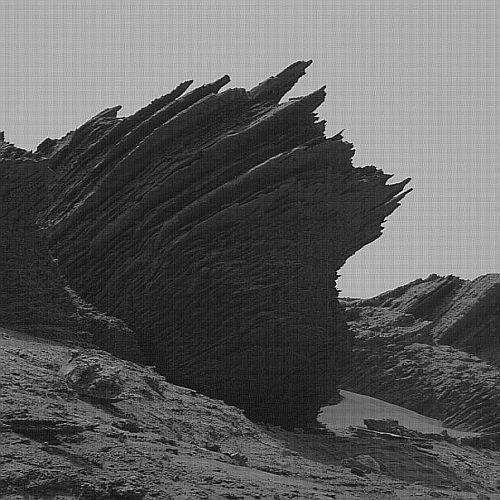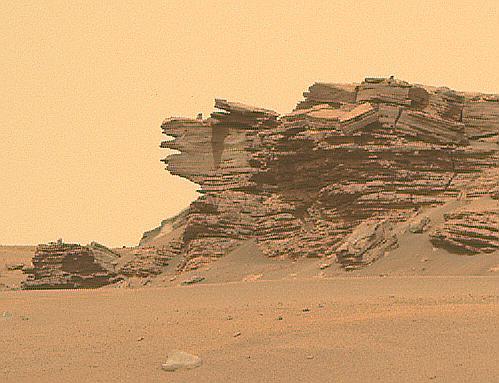Pointy rocks on Mars
We have two cool images today from both of America’s rovers on Mars, each of which illustrates the alien nature of the red planet.
First on the right, cropped, reduced, and sharpened to post here, is a close-up taken by Curiosity’s high resolution camera on May 14, 2022 of the rightmost jagged boulder in yesterday’s navigation panorama. The number of layers is astonishing, though hardly a unique phenomenon as seen by Curiosity in its travels. Each likely marks one of many climate and geological cycles, each laying down another unique stratum for a relatively short period of geological time. Some might be volcanic ash or lava layers. Some might be layers caused by climatic changes.
The ability of these thin layers to extend outward so much, almost like they were floating, illustrates the weak Martian gravity, as well as the thinness of its atmosphere. On Earth, if the wind and weather didn’t cause these flakes to break, the gravity would.
Second on the right, cropped and sharpened to post here, is a high resolution photo taken by Perseverance on May 15, 2022 of one of the cliff faces seen by the rover looking up into the delta in Jezero Crater. Here again we see many layers and jagged, pointy rocks, illustrating again the many cycles in the past that formed the delta as it flowed into the crater.
The smoothness on the surface of the leftmost pointy rock suggests that it has stood in this position for a long very time, allowing the wind of Mars’ very thin atmosphere to erode its rough surface.
On Christmas Eve 1968 three Americans became the first humans to visit another world. What they did to celebrate was unexpected and profound, and will be remembered throughout all human history. Genesis: the Story of Apollo 8, Robert Zimmerman's classic history of humanity's first journey to another world, tells that story, and it is now available as both an ebook and an audiobook, both with a foreword by Valerie Anders and a new introduction by Robert Zimmerman.
The print edition can be purchased at Amazon or from any other book seller. If you want an autographed copy the price is $60 for the hardback and $45 for the paperback, plus $8 shipping for each. Go here for purchasing details. The ebook is available everywhere for $5.99 (before discount) at amazon, or direct from my ebook publisher, ebookit. If you buy it from ebookit you don't support the big tech companies and the author gets a bigger cut much sooner.
The audiobook is also available at all these vendors, and is also free with a 30-day trial membership to Audible.
"Not simply about one mission, [Genesis] is also the history of America's quest for the moon... Zimmerman has done a masterful job of tying disparate events together into a solid account of one of America's greatest human triumphs."--San Antonio Express-News
We have two cool images today from both of America’s rovers on Mars, each of which illustrates the alien nature of the red planet.
First on the right, cropped, reduced, and sharpened to post here, is a close-up taken by Curiosity’s high resolution camera on May 14, 2022 of the rightmost jagged boulder in yesterday’s navigation panorama. The number of layers is astonishing, though hardly a unique phenomenon as seen by Curiosity in its travels. Each likely marks one of many climate and geological cycles, each laying down another unique stratum for a relatively short period of geological time. Some might be volcanic ash or lava layers. Some might be layers caused by climatic changes.
The ability of these thin layers to extend outward so much, almost like they were floating, illustrates the weak Martian gravity, as well as the thinness of its atmosphere. On Earth, if the wind and weather didn’t cause these flakes to break, the gravity would.
Second on the right, cropped and sharpened to post here, is a high resolution photo taken by Perseverance on May 15, 2022 of one of the cliff faces seen by the rover looking up into the delta in Jezero Crater. Here again we see many layers and jagged, pointy rocks, illustrating again the many cycles in the past that formed the delta as it flowed into the crater.
The smoothness on the surface of the leftmost pointy rock suggests that it has stood in this position for a long very time, allowing the wind of Mars’ very thin atmosphere to erode its rough surface.
On Christmas Eve 1968 three Americans became the first humans to visit another world. What they did to celebrate was unexpected and profound, and will be remembered throughout all human history. Genesis: the Story of Apollo 8, Robert Zimmerman's classic history of humanity's first journey to another world, tells that story, and it is now available as both an ebook and an audiobook, both with a foreword by Valerie Anders and a new introduction by Robert Zimmerman.
The print edition can be purchased at Amazon or from any other book seller. If you want an autographed copy the price is $60 for the hardback and $45 for the paperback, plus $8 shipping for each. Go here for purchasing details. The ebook is available everywhere for $5.99 (before discount) at amazon, or direct from my ebook publisher, ebookit. If you buy it from ebookit you don't support the big tech companies and the author gets a bigger cut much sooner.
The audiobook is also available at all these vendors, and is also free with a 30-day trial membership to Audible.
"Not simply about one mission, [Genesis] is also the history of America's quest for the moon... Zimmerman has done a masterful job of tying disparate events together into a solid account of one of America's greatest human triumphs."--San Antonio Express-News




When viewing the full size image you can see a white rock against the base of the cliff. I wonder what it is and where did it come from? Thanks for posting.
‘Dragon’s Lair’ is what I would call these formations of layered and jagged, pointy rocks.
The more images we get from Mars, the more it looks (to me) like those 1950s SciFi movie representations, without John Carter and exotic life forms.
https://www.slantmagazine.com/wp-content/uploads/2015/09/lists_15famousmarsmovies.jpg
Wow!
gary: Except the visual you link to comes from 2012 movie, with its visuals based on images such as this.
Good spot Bob. Maybe this visual from “Robinson Crusoe on Mars” (1964) is better.
https://www.imdb.com/title/tt0058530/mediaviewer/rm1677154560/
I loved old SciFi movies on Saturdays and after school.
gary: Now Robinson Crusoe on Mars is a much better choice. A fine film also.
“The more images we get from Mars, the more it looks (to me) like those 1950s SciFi movie representations, without John Carter and exotic life forms.”
They’re hiding and laying a trap for us Imperialist colonizers. Free Mars! FREEDOM IN THE GALAXY!!
gary–
highly suggest you visit Archive (dot) Org and check out their collection of public-domain SF movies. Everything is free to watch (embedded player) and/or download in multiple qualities.
…some animation…
Bob Clampett
Test Animation (1936)
“John Carter of Mars”
https://youtu.be/bTAlgZlqwnQ
2:27
Looks a lot like Vasquez Rocks, but with extra flake layers! Made from scratch.